Blink of an Eye is perhaps the last truly great episode of Star Trek: Voyager.
There are good episodes that follow Blink of an Eye. There are solid comedy episodes like Renaissance Man. There are effective homage episodes like Author, Author. There are even well-constructed archetypal narratives that fit within the thematic framework of both the series and the franchise like Memorial. However, there isn’t a single episode as elegant as Blink of an Eye, a story which demonstrates the raw potential of Voyager as a narrative engine for telling these big and broad science-fiction narratives.
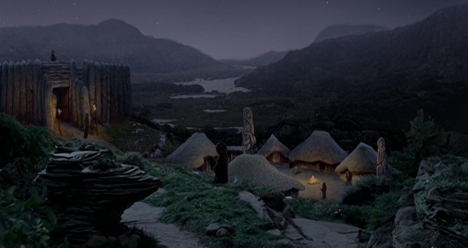
From the mountains of faith…
Indeed, it might even be possible to argue that Blink of an Eye is the last truly great episode of Berman era Star Trek.
There is a tendency to overlook Star Trek: Enterprise in discussions of the franchise’s history and legacy, no matter how quietly influential the prequel series has become in terms of Star Trek Beyond or Star Trek: Discovery. This does a disservice to the last series of the Berman era, particularly the final two seasons that grappled with the question of what it means to be Star Trek in the aftermath of 9/11. Nevertheless, the trauma of 9/11 exerted such a gravity that even the best episodes of Enterprise seemed to exist in its shadow; Judgment, Cogenitor, The Forgotten, Babel One, United.

… through the valley of fear…
Even outside of hyperbole, Blink of an Eye is a beautifully constructed piece of television that speaks to the appeal and the potential of Star Trek. It is a lyrical allegory, a very simple and straightforward idea that is constructed in such a way as to invite the audience to ask profound and meaningful questions about the nature of human existence. What is it like to watch a civilisation rise up? What ideals drive it? Towards what values and ideals might it strive? More than that, what is it like to sit outside of time and watch those beholden to time? These are fascinating and enlightening ideas.
Blink of an Eye was developed from a story by Voyager writer Michael Taylor, one of the most ambitious writers to ever work on the series. Taylor had contributed the stories that would develop into The Visitor and In the Pale Moonlight, demonstrating a willingness to think outside the box. On Voyager, Taylor’s ambitions were frequently tempered and his scripts often compromised. Both Once Upon a Time and The Fight were much more generic and mediocre pieces of television than the original premise. Blink of an Eye is a rare Taylor concept that doesn’t feel watered down.
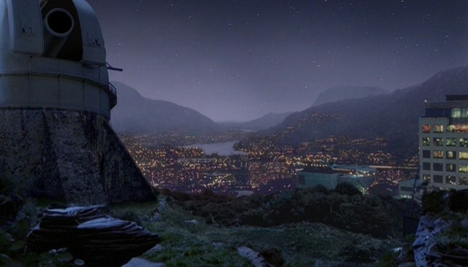
…. But the river is wide
And it’s too hard to cross…
It helps that the teleplay for Blink of an Eye was written by Star Trek veteran Joe Menosky. Menosky had a long association with the franchise and a deep understanding of how it worked, having cut his teeth on Star Trek: The Next Generation and Star Trek: Deep Space Nine. More than any other writer, Menosky understood the idea of Star Trek as a mythic framework, an avenue for exploring stories and what they mean. This theme plays through Menosky’s work on the franchise; Darmok, Masks, Dramatis Personae, Muse.
Blink of an Eye feels like an episode perfectly callibrated to the strengths of Taylor and Menosky, a high-concept episode that is fundamentally about the Star Trek mythos.
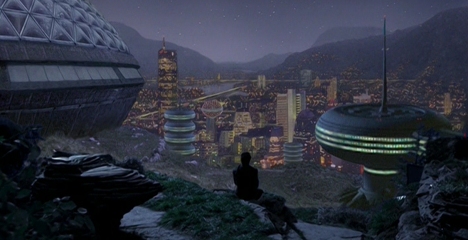
We all end in the ocean
We all start in the streams
We’re all carried along
By the river of dreams.
Discussing the episode with Cinefantastique, producer Brannon Braga conceded that Blink of an Eye posed all manner of logistical challenges to the production team:
That was a very difficult script. It was a really, really tough concept to sell. But we were very pleased with it. It was a very ambitious episode. We did our best to depict the evolution of a civilization over the course of thousands of years. I thought it was fun to go from seeing primitive people to seeing space travel. It had a very large cast and lots of sets, special effects, a very high-concept show.
Indeed, some of these challenges are quite visible on screen, with Blink of an Eye straining against the limitations of television budgets and the constraints of the medium as it existed at the time.
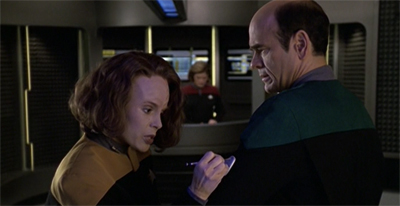
Working out the kinks.
Blink of an Eye confines the entire history of an alien civilisation to a series of short vignettes, mostly shot on the same sets and using less than a dozen actors. There is something strangely intimate about the grand epic sweep of history portrayed in Blink of an Eye; the mountainside where the religion worshipping the “ground-shaker” is also the site of an attempt at first contact and also home to an observatory with its lens trained upon the “sky-ship.” In each case, a small number of characters interact with one another as a microcosm of an entire civilisation.
Of course, these dramatic contrivances can all be explained or justified. After all, Blink of an Eye makes it clear that there is never one singular religion on the planet; even within the isolated geographical area within which the story unfolds, the technician and the astronomer have radically different ideas of what the “sky-ship” represents. Blink of an Eye has just chosen to look at the conversations and revelations taking place on this hill. It seems likely that similar conversations have taken place, with slight variations, across the entire planet throughout history.
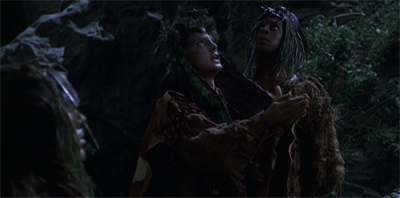
Altaring this planet’s history.
It seems likely that those primitive tribes in the first vignette were not the only people to witness the arrival of the new star, and not the only to build the harbinger into their mythology. Similarly, it seems unlikely that Kelemane was the only (or even the first) inhabitant of the planet to speculate that direct communication was possible with whatever that star represents. Even the scene in the observatory makes it clear that the inhabitants of the planet have been trying to contact Voyager for quite some time, it just so happens that this is the message that the ship happens to hear.
Even without these appeals to logic and rationality, there is an appealing purity to how Blink of an Eye depicts its science-fiction high concept. The decision to set the bulk of Blink of an Eye within a relatively confined area allows the show to anchor the audience in a very fixed view of the planet, giving them a very defined perspective from which they might watch the planet evolve. The episode offers a convincing portrayal of the passage of time through canny use of digital artwork.
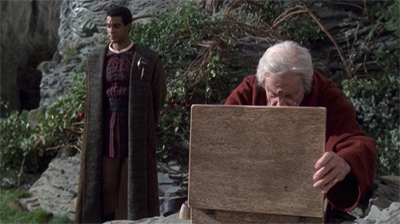
He’s on the case.
Blink of an Eye uses the same location in its establishing shots of the planet surface, while acknowledging that those shots are set centuries apart. Blink of an Eye fixes its perspective in space, but not in time. As a result, the audience gets to watch a snapshot slideshow of the evolution and development of this culture, the growth of the community from a few scattered huts to a castle to an observatory to a science-fiction future. It is very confident and very assured televisual storytelling, remarkable given that Voyager was usually quite conservative in such matters. It recalls the montages in Counterpoint.
Even beyond the clever concept of showing the same view across four different time periods, these vignettes from the planet surface have an appealingly archetypal quality. The characters are all very broad, with Kelemane, Gotana-Retz and Trina receiving names. The characters talk in very generic terms about their world, so as not to confuse audience members with overly-specific back story. The scenes set on the planet surface are consciously heightened, having that abstract theatrical quality that defines so much of Star Trek.
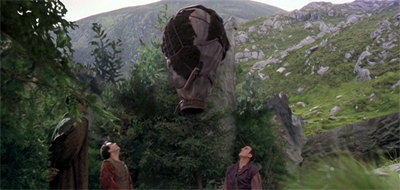
Time literally flies.
There is an artifice to Blink of an Eye, but that is a key strength of the episode. Star Trek has very rarely managed to present a naturalistic or entirely convincing version of the future, arguably rooted as much in the theatrical tradition as in cinematic storytelling. It is no coincidence that so many beloved Star Trek actors established themselves on the stage rather than the screen. Blink of an Eye condenses the entire history of a civilisation down to something approaching a stage play; small groups of actors on standing sets talking about grand philosophical constructs.
After all, Blink of an Eye is about more than just this history of this fictional world. It is not particularly interested in the finer details of the political relationships between various states or the mechanics of local sports teams, except that occasional references add a little flavour and texture to this civilisation. Instead, Blink of an Eye is a story about history and time, about what it is to sit outside of time and watch as history unfolds. Although these ideas are explored repeatedly across the Star Trek franchise, they are of particular interest to Voyager.
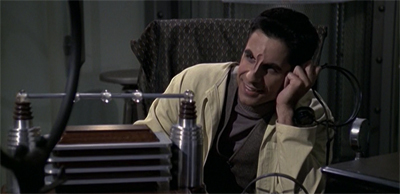
Time out.
Voyager is a television series very invested in the idea of history and time, as reflected in the disproportionately high quantity of time-travel-related episodes across the length and breadth of the series; Time and Again, Future’s End, Part I, Future’s End, Part II, Year of Hell, Part I, Year of Hell, Part II, Timeless, Relativity, Fury, Shattered, Endgame. These are only the most literal of time travel stories, glossing over stories where the audience moves forward or backwards in time even as the crew remain fixed in place, as in Living Witness or 11:59.
The basic premise of Blink of an Eye is so deceptively simple that it is surprising it took the Star Trek franchise so long to attempt it. Voyager finds itself pulled into orbit around a strange planet with “a high rate of rotation, approximately fifty eight revolutions per minute.” In layman’s terms, that means that time moves considerably quicker on the surface of the planet. “For each second that passes on Voyager, nearly a day goes by on the planet,” Seven of Nine explains, although the episode wisely avoids getting too specific about the mechanics at play.
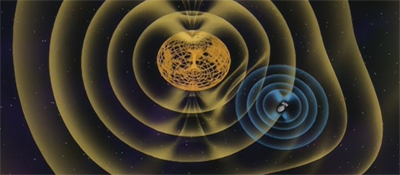
Polls apart.
Time dilation has long been a fascination for science-fiction storytelling, dating back to H.G. Wells’ short story The New Accelerator at the latest. In some ways, science-fiction’s love affair with time dilation could be seen as an attempt to narrativise the core aspects of Einstein’s theory of relativity. As Jimena Canales notes, one of the major criticisms of Einstein’s reconceptualisation of space-time in the twentieth century was that it was too literary in concept:
Many readers swallowed relativity stories as quickly as they could be printed, but the French philosopher Henri Bergson, who had attended Langevin’s relativity lecture years earlier, was profoundly irritated by scientists’ growing prominence as public intellectuals. The philosopher had been, until then, more famous than Einstein, known for having launched his own “Copernican revolution” (as William James put it), which introduced a notion of time that could not be reduced to clocks. Einstein and Bergson quibbled with each other’s views for the rest of their lives. The physicist’s talent, the philosopher implied, was not so different from that of H. G. Wells, whose novel “The Time Machine” had considered time as a fourth dimension, just as general relativity did; perhaps both fascinated the public because of their fictional qualities more than their scientific ones. Relativity enthusiasts, he argued, should be careful to “distinguish the real from the symbolic,” to avoid elevating “a mathematical representation into transcendental reality.” They should go back to the original equations and seek to connect them to the “really real”—in other words, that which could actually be perceived. Nowhere could the philosopher find cigar-smoking aviators or transplanetary love stories.
Indeed, science-fiction stories that exploit relativity often approach it in a metaphorical rather than literal manner, understanding the universal and symbolic power of the idea of time passing at different rates for different individuals. Christopher Nolan’s Interstellar is a story about time dilation caused by gravity disturbances, but it is also an allegory for the more relatable experience of an individual watching their children grow up without them.
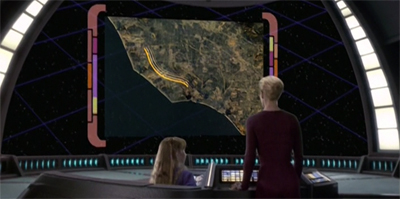
Coasting.
Interestingly, Star Trek has been somewhat cautious about playing with these sorts of big ideas, at least on television. Perhaps this is because the franchise is aimed at a wide audience, and the production teams are wary about alienating viewers without a basic grasp of physics. Maybe this is an acknowledgement of the fact that the faster-than-light travel and transporter technology in Star Trek are of a much softer kind of science-fiction, and applying too much rigourous hard science-fiction might bring the whole house of cards tumbling down.
Writer David Gerrold’s original pitch for the original series, which he later developed into the novel The Galactic Whirlpool, was built around the concept of relativity. He conceived of a generation ship caught in orbit of a singularity that sped up the passage of time. This idea was rejected for a variety of reasons, and Gerrold would make his debut writing for the franchise with a rewrite of the script for the android comedy I, Mudd and the all-time classic The Trouble with Tribbles.
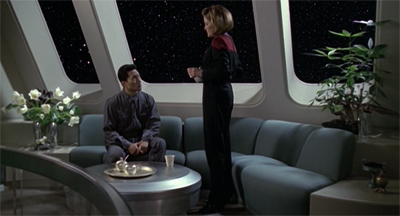
Astrophysics just aren’t most viewers’ cup of tea.
It would take televised Star Trek a few years to catch up. Although the franchise played with causality and time loops in episodes like We’ll Always Have Paris and Cause and Effect, the first real episode of The Next Generation to broach the idea of relativity was Timescape, in which the Enterprise is frozen in time by phenomena related to the singularity used to power a Romulan Warbird. Years later, Gravity exploited relativity in order to strand Tuvok and Paris on the surface of an alien planet for an extended period of time, while Voyager’s rescue mission plays out over the course of a few hours outside a singularity.
The basic concept of Blink of an Eye owes a massive debt to Robert L. Forward’s Dragon’s Egg, the 1980 hard science-fiction classic that the author described as “a textbook on neutron star physics disguised as a novel.” In that story, life is seeded on planet orbitting a neutron star, with humanity watching as civilisation develops and evolves at an incredibly accelerated rate. There are obvious parallels with the basic plot of Blink of an Eye, although Voyager understandably streamlines the concept for a prime-time television audience.
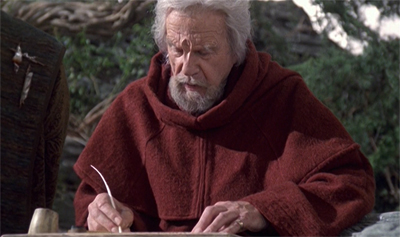
And it was written…
In many ways, Blink of an Eye is a classic and archetypal Star Trek story, a clever science-fiction high-concept that provides an allegory for some aspect of the human condition; on the dangers of “othering” what is different in The Devil in the Dark, on the experience of a life lived in The Inner Light, the challenges of adjusting to life after incarceration in Hard Time. It is easy to imagine a version of Blink of an Eye within the confines of The Next Generation or even Deep Space Nine.
(Although Deep Space Nine did high-concept science-fiction less often than the other Star Trek series, it tended to compensate by filtering through a more personal perspective. Deep Space Nine often seemed to ask what these wacky high-concepts meant to individual characters, with the “O’Brien must suffer” episodes like Whispers, Visionary or Time’s Orphan feeling like meditations on what it would be like to be a person living through the crazy stuff that happens in the Star Trek universe; android doppelgangers, time travel, time distortion. Were Blink of an Eye a Deep Space Nine episode, it would focus on the EMH.)
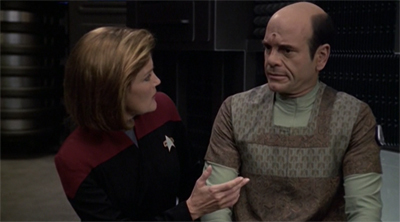
“Now I know how O’Brien feels.”
However, buried within Blink of an Eye is a story that is very specific to Voyager, tapping into ideas that are core themes of the long-running series. In particularly, it is telling how Blink of an Eye chooses to place Voyager outside of the accelerated space-time on the planet surface, presenting the ship and crew as a universal constant. Whether as the “ground-shaker” or the “sky-ship”, Voyager is a permanent fixture. It is a constant, even as the world beneath it changes and evolves.
Blink of an Eye makes a point to stress just how much change takes place for the inhabitants of the planet over the course of the episode. The changing backgrounds provide a clear sense of social progress, as do little changes in language about how they talk about Voyager. The ship is initially an angry god shaking the heavens, but their understanding of it grows over the course of the episode. First it is another city, then it is recognised as a space craft. Along the way, costuming and technology evolves.
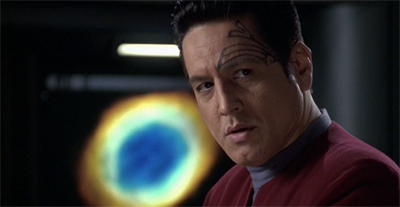
Seconds in command.
In contrast, Blink of an Eye suggests that Voyager exists outside of time, while these characters below live and die. “It’ll take a few hours to make the adjustments,” Torres remarks of plans to snap pictures from the planet surface. “A few hours?” Chakotay sighs. “We might miss the rise and fall of a civilisation.” Torres responds, “So we’ll watch the next one.” There is a sense that life is transient, that the world beneath Voyager spins and whirls, while Voyager remains above and outside of time.
This idea is reinforced by the small arc focusing on the EMH, who is absent from Voyager for only a few minutes, but lives an entire life on the planet surface. Making passing reference to “Mareeza”, the EMH elaborates, “She was my roommate. Three years is a long time, Captain. One needs companionship.” In a later conversation with Gotana-Retz, the EMH reveals that he started a family on the planet surface, and that his descendants might live on. The EMH does not reveal any of this to his crew mates. They would not understand. They exist outside of the flow of time.
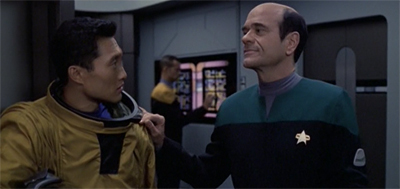
“In hindsight, I do feel like a bit of a hypocrite for giving Janeway such a hard time last week.”
As Duncan Barrett and Michèle Barrett note in Star Trek: The Human Frontier, the episode is very engaged with idea of time as it relates to history:
In this, Star Trek is not far removed from the efforts of some historians. Bill Schwarz, discussing the ‘relativisation of the conception of historical time’, quotes the historian Fernand Braudel’s summation of his life’s work: ‘My great problem, the only problem I had to resolve, was to show that time moves at different speeds.’ This is not the same register of analysis as the observation of a distinction between subjective and objective time – that time goes slowly when you are bored and rapidly when you are enjoying yourself. It points towards the sense of variability in the passing of historical time, as well as the implications, for the experience of time, of post-Einstein astrophysics.
It is a fascinating concept.
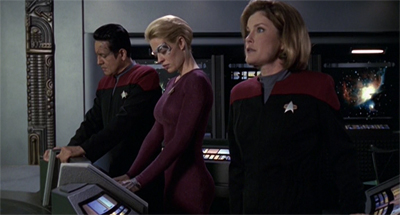
A guiding light…
This is very much in keeping with how Voyager approaches the idea of time, and it is appropriate that Blink of an Eye was only the second episode of Star Trek to broadcast in the year 2000. The turn of the millennium technically marked the end of the nineties, but the decade lingered on. The world did not end at the stroke of midnight, at the turn of the millennium. Life continued as normal, as Voyager had confidently (and correctly) predicted in 11:59. There was no massive social upheaval, no change in cultural consciousness.
The nineties seemed to exist in perpetuity, lacking the same closure that the collapse of the Berlin Wall brought to the end of the eighties. Time seemed frozen. People would be forgiven for wondering whether Francis Fukuyama had been correct in declaring “the end of history” or whether Charles Krauthammer’s “unipolar moment” would last indefinitely. Politically, the decade continued through at least September 2001, although nobody could have known that at the start of the twenty-first century.
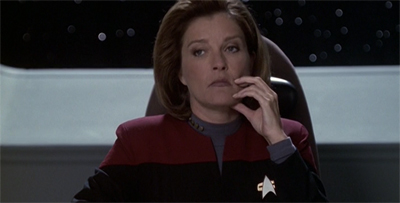
Warping in place.
This sense of stasis extended beyond the political sphere. Art critic Jason Farago has argued that the nineties never ended in an artistic or creative sense:
Some of the art of the 1990s looks decidedly dated. Net art went the way of “You’ve got mail.” Slick, digitally altered large-format photography has gone out of fashion, too; Sam Taylor-Wood (now Taylor-Johnson) gave up art completely and is now directing the softcore Hollywood flick Fifty Shades of Grey. But what’s surprising – and a little disturbing – is how much art from the 1990s could have been made last week. It’s not just that the themes of the ‘90s, from the meaning of identity to the impact of economic transformations, are our themes too. It’s also the style and the feel of the ‘90s that endures, so much so that these historical exhibitions of ‘90s art can feel almost comically fresh.
What if the 1990s, far from being ancient history, are actually still going on? The social practices of gallery spaces that arose in that decade remain the lingua franca of contemporary art everywhere, and video installations that were innovative in the ‘90s now form part of every contemporary exhibition. Since then… what’s new? There has been a noted turn to performance in the 21st Century, and a market-happy revival of abstract painting, but other than those small trends the ‘90s settlement endures. People will still queue for a free curry in an art museum; the only difference is that they snap it with their cameraphones before eating.
The nineties exist outside of time, a concept that plays repeatedly throughout the run of Voyager.
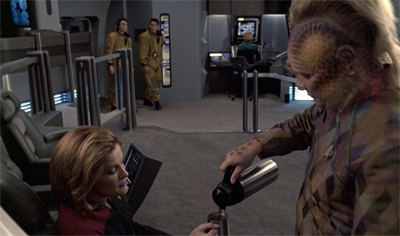
Stuck in a moment.
After all, Voyager did represent the end of history for the Star Trek franchise, in a very literal sense. It is the last Star Trek series, from a chronological perspective. Enterprise and Discovery both retreat into the franchise’s history. Even within the context of the series itself, Voyager has difficulty imagining a future where anything is radically different. It is no surprise that Voyager was the first Star Trek series to imagine a very distant future beyond its own setting, and the only series to insist on the rock-solid stability of that future.
Voyager seemed to imagine what might be termed a “Pax Federation”, a future in which the Federation were not only a dominant political force in space, but also charged with protecting time itself. Whereas Deep Space Nine suggested that the Federation’s present was under threat and Enterprise repeatedly warned viewers that even the future they had been shown was no longer assured, Voyager could not conceive of a future where anything had changed beyond the uniforms and the techno-babble; Future’s End, Part I, Future’s End, Part II, Timeless, Relativity, Endgame.

Stony resolve.
It should be noted that this attitude is not unique to Voyager, but instead reflects a larger cultural movement. As Lutz Niethammer observed in Posthistoire: Has History Come to an End?, there was an emerging school of “posthistorical” thought:
Two aspects distinguish the posthistorical cluster of arguments from writings which may, in some respects, be quite similar: first, their reference back to, and self-location within, a tradition of the production of meaning for which they no longer see any social future; and second, their avoidance of thinking about death, especially about the danger that modern civilisation will annihilate itself and the world, which is the central preoccupation of other writers. Instead, the picture that looms for theorists of posthistory is of a mortal life lived without any seriousness or struggle, in the regulated boredom of a perpetual reproduction of modernity on a world scale. The problematic of posthistory is not the end of the world but the end of meaning.
Voyager seems to epitomise this anxiety, imagining a future without any future itself. Even in Living Witness, an episode in which the EMH finds himself thrown into the thirty-first century, the primary focus is on the past.
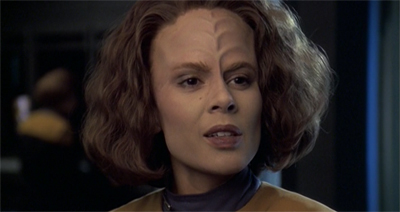
The end is (engi)neer.
Voyager seems to fit within this mode of “posthistorical” discourse. What is Voyager (and the futures portrayed within Voyager) but “a mortal life lived without any seriousness or struggle”? The conflict between Starfleet and the Maquis was baked into the premise of Caretaker, but brushed aside casually in Parallax. Episodes like Year of Hell, Part I, Year of Hell, Part II, Equinox, Part I and Equinox, Part II hinted at alternative worlds where Janeway’s journey was filled with seriousness and struggle, but existed in contrast to the perpetual pleasure cruise that defined most of the rest of the run.
Similarly, the world and the futures of Voyager emphasise “the regulated boredom of a perpetual reproduction of modernity on a world scale.” On Deep Space Nine, it frequently seemed like the future was something that had to be fought for and earned; Inter Arma Enim Silent Leges revealed that the final stages of the Dominion War were spent planning for the political turmoil that would extend beyond What You Leave Behind. In contrast, it seemed like Starfleet faced no significant challenges to its political supremacy, the future just an extension and expansion of the present.
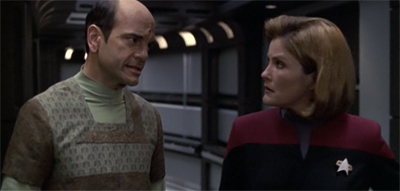
“Now, let us never speak of this again.”
So Blink of an Eye allows Voyager to literally stand outside of history, to watch time flow for the people on the planet surface while everything remains static on the ship itself. The implication is clear, Voyager exists outside of time, quite separate from the flow. Indeed, it is revealing that the environment of the planet is not just accelerated but incompatible to Voyager. When Gotana-Retz and Trina find themselves on board Voyager, they discover a moment suspended in time. It recalls the imagery of Voyager buried beneath the ice in Timeless, literally frozen.
Blink of an Eye suggests that there is something more than just time and gravity that separates the inhabitants of the planet from the characters on the ship. Unlike Interstellar, it is not easy for characters to navigate between the various time flows. Torres classifies Voyager as a “disruption” to the flow of time on the planet, its presence causing chaos on the surface. The EMH is the only character who can beam down to the surface. Trina and Gotana-Retz have to violently transition into Voyager’s timeframe, with the shock to their systems so great that Trina does not survive.
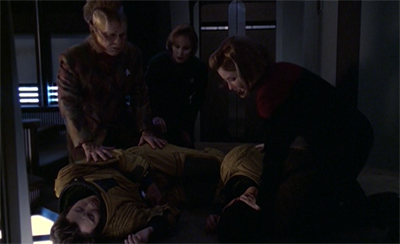
Time’s up.
It is not merely that time moves slower on Voyager, it is that Voyager exists outside of time. The introduction of time to Voyager is seen as something dangerous, an idea that is repeated at several points over the course of these final seasons; the return of an aged Kes in Fury and the fracturing of the ship’s timeline in Shattered. Indeed, the sight of Trina and Gotana-Retz collapsing on the bridge suggests that of fish that have jumped out of water. There is a sense that there is some vital element of their existence that is sorely lacking on Voyager.
However, Blink of an Eye is about more than just Voyager. In some ways, it feels like a commentary on Star Trek itself. It plays as a genuine and sincere ode to Star Trek fandom, an interesting counterpoint to the more obvious and patronising portrayal of fandom in Pathfinder. There is a sense that Voyager is not only standing in for Voyager over the course of the episode, it is standing in for the abstract concept of Star Trek as a cultural construct. This would explain why the episode’s treatment of the natives’ attitudes to Voyager is different than similar attitudes in Who Watches the Watchers?
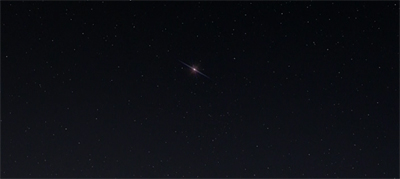
Star shining bright above you…
The inhabitants of the planet are treated as Star Trek fans. Indeed, there’s a repeated emphasis on “sky ship” merchandise that has become a fixture of children’s lives. “So you weren’t one of those children that had the entire series of Sky Ship Friends?” the astronomer asks the technician. The technician responds, “Actually, I had them all, even the duplicates. You couldn’t walk into my home without tripping over a Friend or two.” Gotana-Retz tells Janeway, “When I was a young child, the toys hanging above my crib depicted the Sky Ship.” The EMH talks about “children’s toys.”
When asked what the inhabitants know about Voyager, the EMH explains, “They blame us for the seismic tremors but everything else is pure speculation. And let me tell you, they like nothing better than to speculate about Voyager.” He elaborates, “Our presence has encouraged invention, religion, science, art even children’s toys. They’re all variations on a single theme, Voyager.” Indeed, the existence of Voyager inspired direct innovation, “There’s something of a space race going on between the various states. Who can get to the starship first with a rocket?”

A trek to the star.
Although there are shades of religion to the relationship between the inhabitants of the planet and the ship in their orbit, Blink of an Eye suggests that their interest is more spiritual in nature. When pressed to account for his involvement in the project, the technician assures the astronomer, “I hope someone is up there.” It’s a simple idea, but one stated eloquently. It suggests a message of hope and idealism. Blink of an Eye suggests that “the sky ship” never inspired an inquisition or human sacrifice, and that investment in it extends beyond even rational and scientific education.
As such, it feels like a metaphor for the impact that Star Trek has had on popular consciousness. After all, Star Trek has been likened to a religion, and shares some of the same spiritual properties: a core set of beliefs, a “canon”, even ritualised celebration. Much has been written about the franchise’s social utility, particularly its use as a vehicle for discussions of abstract moral concepts and philosophical ideas. Also, there has been lots and lots (and lots) of Star Trek merchandise that has helped to integrate the franchise’s iconography into the popular consciousness.
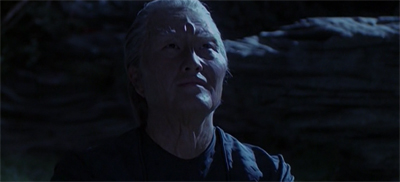
The old man and the sky.
However, Star Trek has also contributed to material social progress, despite being something intangible and abstract. The show has a long-standing relationship with NASA. It inspired Mae Jemison to become an astronaut. As Karl Stapelfeldt, the chief scientist for NASA’s Exoplanet Exploration Program, explains:
Star Trek presents a widely accessible vision of what might be out there in the broader universe. People’s interest in the show can be a launching point to discover the real science of astronomy and the real engineering of space travel. A lot of people in aerospace or science are fans of the show, not because we want to act out episodes, but because we’d love to travel/explore/learn about our universe. We’d like to do this not just for ourselves but for the whole world, for all people who are curious about what’s out there and how humanity fits in.
There is something romantic in that idea, that the utopian future of the Star Trek franchise can inspire to people to imagine a world beyond their own, just as looking up at a star in the night sky could inspire the aliens in Blink of an Eye to reach towards space. Blink of an Eye even explicitly acknowledges this idea of Voyager serving as an abstract influence on the planet’s population. “Perhaps they’ll miss Voyager so much, they’ll do everything they can to follow us.”

Astro-not, eh?
Blink of an Eye imagines Voyager as a metaphor for Star Trek, an abstract concept more than a concrete object. It is something that seems to exist outside the harsh contours of the present moment, something that endures and lasts. Many fans and pundits would argue that Star Trek is “timeless”, and this seems like a fair observation. The franchise has remained popular for a much longer period than many of its contemporaries, and remains relevant to the modern world. Episodes like Errand of Mercy and Balance of Terror remain potent, even half a century away from broadcast.
However, there is also something bittersweet in the way that Blink of an Eye positions the Star Trek franchise outside of time. There is something tragic in the way that the world beneath Voyager seems to evolve past the ship. After all, the plot hinges on the planets’ inhabitants evolving to such a degree that they can forcibly eject Voyager from orbit. More to the point, this ejection follows on from an earlier sequence in which the planet starts firing torpedoes at Voyager. “They have no right,” Gotana-Retz argues. Janeway responds, “Unfortunately, they’ve got every right.”
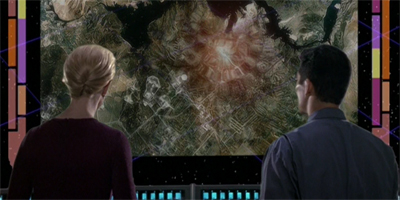
Launch time.
There is something very melancholy in the idea that the world might have moved past Star Trek, but it fits with one of the recurring anxieties of the later seasons of Voyager. After all, The Voyager Conspiracy was a bitter rejection of serialisation, one that often felt like an acknowledgement of Voyager‘s refusal to evolve with the television around it. The framing device of Pathfinder seemed deliberately structured to evoke The Sopranos, the poster child for television’s great leap forward in the final years of the twentieth century.
The final seasons of Voyager were written and broadcast just as the first drops of blood were entering the water. The franchise had coasted softly down from the high of the thirtieth anniversary, with the success of Star Trek: First Contact and Trials and Tribble-ations. With Deep Space Nine off the air, Voyager became the sole standard bearer for the Star Trek franchise, and one subject to the whims of a fickle network. The franchise had just endured the humiliation of Star Trek: Insurrection.
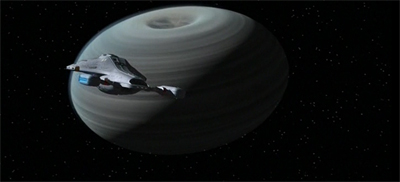
As the world turns.
Very fast, apparently.
Of course, things could be worse. In fact, things would get worse. Voyager was still a relatively popular show on UPN. Rick Berman and Brannon Braga were already working on the series that would become Enterprise, the Star Trek show that would replace Voyager in UPN’s line-up. There was still some blood left in the Star Trek franchise, and the Berman era had another five years of life left in it. At the same time, there was a sense that the production team were mulling the franchise’s mortality for the first time in quite a long period.
Rick Berman has since suggested that he wanted Star Trek to be allowed to lie fallow after UPN retired Voyager, hinting at some awareness of a changing cultural mood. The departure of Ronald Moore from Voyager at the start of its sixth season had opened the floodgates for vitriolic and embittered internet fandom. Newspapers openly speculated about the long-term viability of Star Trek as a franchise. Death was not yet at the door of the Berman iteration of the Star Trek franchise, but it lingers on the horizon.
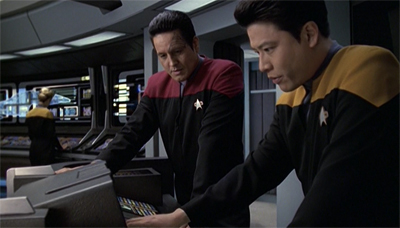
“Don’t worry, we’ll always have characters as compelling as Chakotay and Kim.”
Blink of an Eye seems to make peace with this fact, five years ahead of time. If the final two seasons of Enterprise rage against the dying of the light, Blink of an Eye accepts the end of this iteration of Star Trek with rare dignity and restraint. It is an episode that dares to imagine a future in which Star Trek simply may not be there, when one of the great guiding lights of popular culture might disappear from view, having lost the power to make the world tremble before it. The closing scene of Blink of an Eye is a beautiful farewell to a force that changed the world.
“I feel like I’m saying goodbye to an old friend,” Gotana-Retz confesses to Janeway in their final scene together, before the closing moments of the episode show an old man watching the ship leave orbit. If this is goodbye, it is a measured and considered farewell. It is the kind of farewell that is only possible through acknowledging the passage of time.
Filed under: Voyager | Tagged: abstract, blink of an eye, einstein, end of history, End of Time, history, star trek, star trek: voyager, time, timeless, voyager |




















I watched this over the weekend for the first time after reading this review. Wow! It’s a surprisingly good episode. There’s some clumsy dialogue early on (or perhaps Robert Beltran was just sick of trying to make bad dialogue work), but once it gets going it is surprisingly engaging. It feels like it’s part of a Joe Menosky “reflection on Star Trek as a cultural symbol” trilogy, along with Muse and Living Witness.
Also, I once met Daniel Dae Kim, so I think this may be the only VOY episode where I’ve directly met one of the actors involved 🙂
Thanks! On the one hand, I’m glad that you took my advice. On the other hand, I feel bad that there won’t be another episode that I can as wholeheartedly recommend between now and the end of the Voyager reviews. But, hey, it’s pretty damn fantastic.
This was an incredible episode, I was so transfixed by the story that I remember the vivid details of what I was doing when I watched it during its original broadcast when I was only 10 years old. I always thought of this episode as a classic, but then I watch SFdebris’s review of the episode, where he savaged it for being a rip-off of the book Dragon’s Egg. He even clarified in an episode years later on the difference between Homage vs Ripoff. https://sfdebris.com/videos/startrek/v933.php
And because of this, I don’t know what to think about it anymore. The first I ever heard of this kind of story was from Voyager in the original broadcast, and it may have even sparked my interest in history and lead me to play the Civilization games. But how much credit can I really give Voyager for that? I don’t know anymore.
I mean, a lot of stories share similar premises and ideas. And the idea of time being relative is broad enough that I think it’s entirely possible for Blink of an Eye to be an example of parallel development. Not least because this story is similar to the very first idea that David Gerrold pitched to Star Trek in the late sixties, as mentioned in the review. He developed that idea into a tie-in novel.
Much like I take Vince Gilligan at his word when he says Drive is not a rip-off of Speed, but instead of a Homicide episode.
I recall when I first watched this episode, I loved it for what it was but was found myself thinking about what it wasn’t.
For me personally, a big strength of this episode is that it ends in a way which both brings closure but also leaves room for a lot of speculation.
If the inhabitants of the planet do go off into space, how would the interactions go between those who leave and enter a ‘normal’ flow of time and everyone else where time flows at a relatively far slower rate?
In this episode the planet itself didn’t really have to deal with the temporal divide between their planet and everywhere else – it was just their normal. But if they do venture beyond their planet in a sustained way, that would affect personal relationships and life in dramatic ways.
Looking back now, I appreciate the episode in more of a meta-sense, given that TNG, DS9 and VOY are from an era of Star Trek which has now passed.
PS. There’s a little typo when you wrote, “suggests that of wish that have jumped out of water.”
Thanks James! Typo is corrected.
No mention of “Wink of an Eye” the original Trek episode with Kirk that this is a re-telling of? Nerd Fail.
Dear Darren,
I just want to say: love your reviews. You take the reviews of these episodes to a whole new level, with philosophical and historical takes on the episodes and with broader views of the whole franchise.
You give me a new perspective on Star Trek, and to get a new perspective on something in life, that is a rare gift.
Thank you.
Thanks Harmen. This means a lot to me. I really appreciate it.
One thing I wondered was why the people on the planet couldn’t see the time difference. It should have been noticeable in the movements of stars and other bodies in their system (if there were any.) Also, the Doctor mentions that they had only one brief war while he was there, although it seems they would have had many other conflicts with so many nation states in such a crowded area (the “medieval” period showed a castle, which is a defensive structure).
I think a lot of that is just down to narrative simplicity and efficiency. It’s a pretty big high concept as is, and I think over-complicating it would have taken away from the more lyrical and poetic quality of the episode. Then again, I am quite partial to Joe Menosky’s approach to Star Trek, which tends towards these sorts of metaphors and narrative devices more than traditionally hard science (and inevitably techno-babble-driven) approaches.
A very enjoyable “hour”, I fully agree. I just got a headache about the physics of the transition between the two time areas but it does not need to make absolutely and logically sense for the story to work as well as it does.
My only two quibbles are that the scriptor writes visibly in English when they try to send a message in a balloon to Voyager. And I think there should have been some more lasting change to the Doctor – It was just three years, but it still reminded me a lot of Picard’s experience in “Inner Light”. At least his interest in singing got some new nourishment before really taking off in the next episode.
As always I am impressed by your ability to link story and production context, Darren. It never occured to me that this episode was sort of a farewell to good old Star Trek, but indeed, it does make some kind of sense, especially given the archteypical quality of this story. The imagery of a frozen crew speaks for itself…
Yep. It’s one of my favourite Voyager episodes because it plays like an old-school Star Trek fairy tale.
I’m not a Trek fan and watched this specific episode because it sounded similar to the classic Simpsons halloween segment ‘The Genesis Tub’ where Lisa’s baby tooth spawns a miniature civilisation that rapidly develops technology.
I guess I’m still not a massive fan, but wanted to say I found this post really in-depth and thoughtful, and I’ve enjoyed reading up on Einstein vs. Bergson!
Thanks Daniel! Glad you enjoyed.
I think that Simpsons episode is specifically referencing a Twilight Zone episode, The Little People.
I really like this episode however I can’t get my head around how the people on the planet could see stars when they were spinning so fast. Surely they would have just seen elongated blurs across the night sky. Also, was Voyager captured by the planets rotation and spinning as well? If so they would’ve been no time difference. If not, how did they stay focused on just one part of the planet when the planet’s surface was going past them at such a high speed? I still really love this episode but would appreciate if someone could explain this to me.
I’ve always liked this episode as one of the top 10 Voyager episodes (in my book). As some above have suggested, it is reminiscent of the Civilization video games, where we have archetypes of ‘progress’, viewed through a shot of a valley that iterates with architecture over time.
I also agree that the doctor should have been more permanently affected by his three years (with a partner and son apparently) down on the planet. But who are we kidding? This is Voyager, and we have to hit the reset button. That said, it would have been more interesting if the doctor had been left down on the planet for 20-60 years and had come back and been enraged at being ripped out of his life, and was a totally different character, lol.
As other have noted, one of the most obvious common sense plot holes is the idea of the sky. While I get that Star Trek is not hard sci fi, it doesn’t take a rocket scientist to realize that the planet’s sun (and stars) would be a flickering band of light in the sky. This would also radically alter evolution on the planet. Any sentient life would likely be freakishly different to humans. Indeed, the doctor seems to fear the planet will be inhabited by purple blobs or something. It’s a shame Voyager can’t even embrace the weirdness that such a world could provide. Instead, it’s just another forehead of the week.
Lastly, the biggest and most frustrating plot hole here: Based on the rate of technical progress that Voyager witnesses, they should have sent the doctor back with a mission to help with the R&D of tech to get Voyager home, either through some sort of gateway or an advanced warp system. All Voyager would have needed to do was hang out for a day, week, or whatever. They literally fly away from a free route home. This drove me nuts when I first saw the episode 20 years ago. It still does.